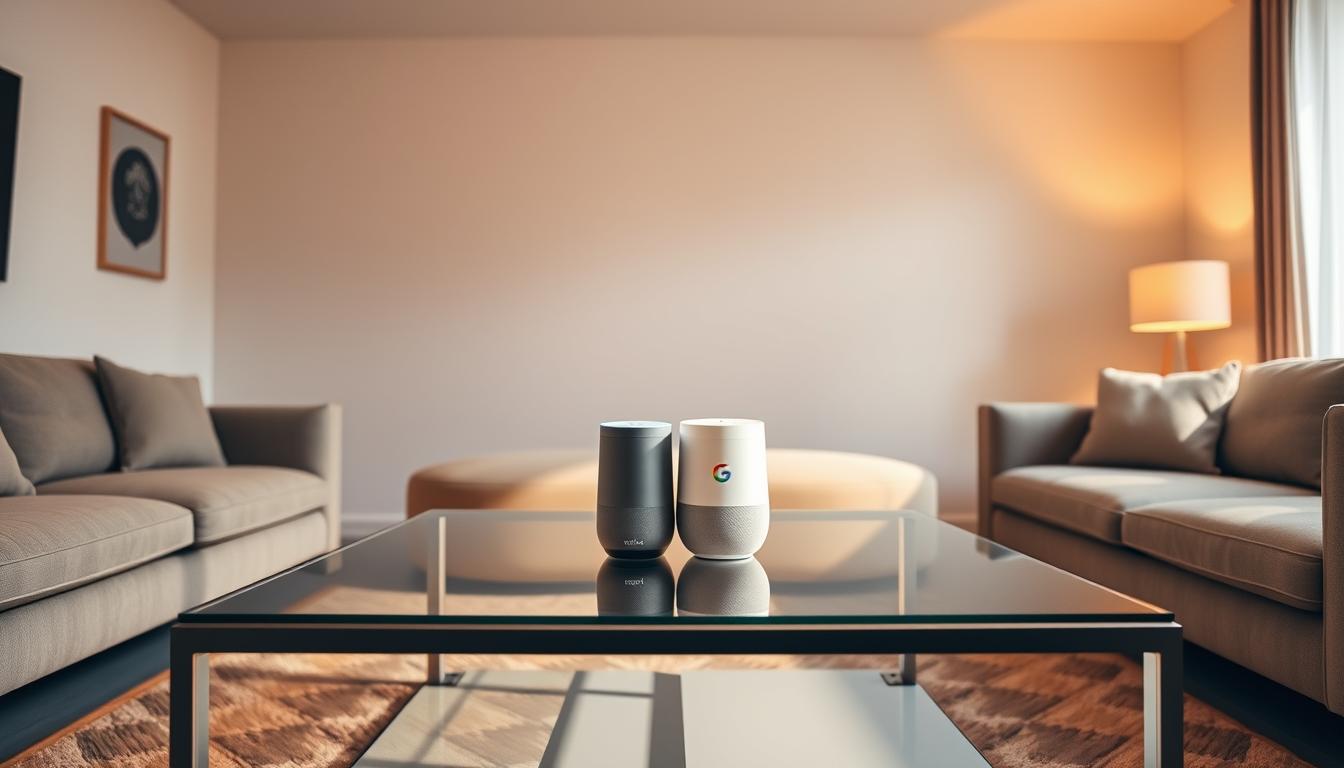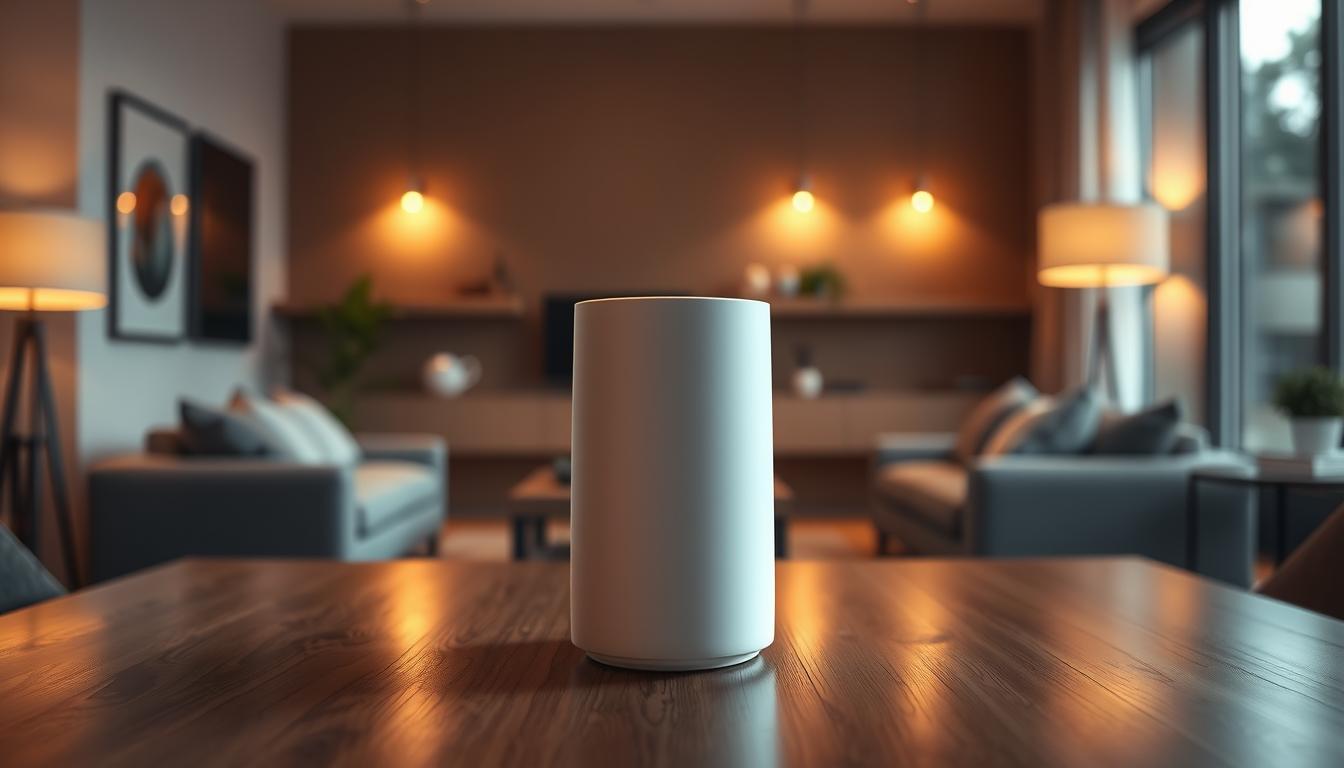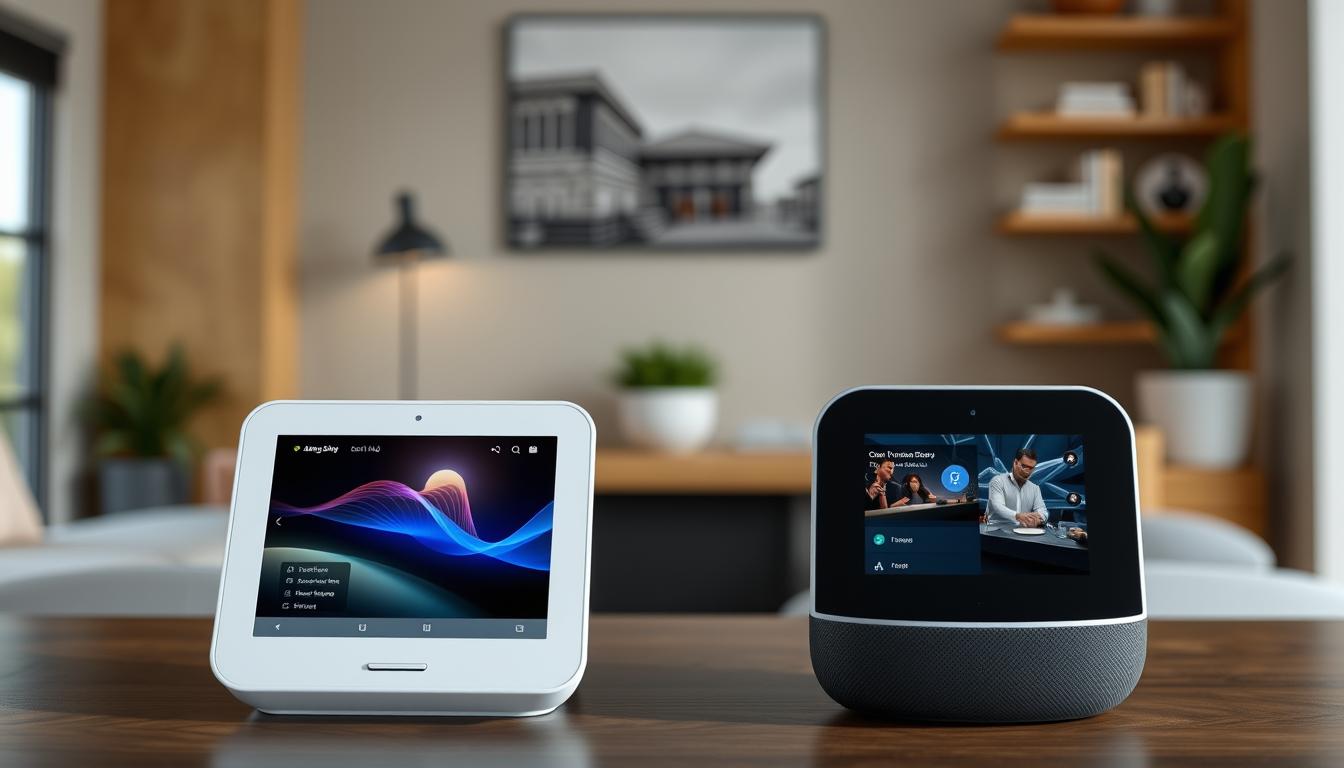As technology advances, smart home devices are becoming increasingly popular, making it easier to control and automate various aspects of our lives. With the rise of voice assistants, homeowners can now manage their devices with simple voice commands.
The two leading voice assistants are Amazon's Alexa and Google Home. Both offer a range of features and capabilities, but which one is better suited for your smart home needs? In this article, we'll explore the differences between these two platforms and help you make an informed decision.

With the ability to control lighting, temperature, security, and entertainment systems, smart home assistants have revolutionized the way we live. But with so many options available, choosing the right one can be overwhelming.
Key Takeaways
- Comparison of Amazon Alexa and Google Home features and capabilities
- Overview of compatible devices and ecosystem integration
- Discussion of voice recognition, pricing, and music support
- Examination of privacy considerations and security features
- Guidance on choosing the best smart home assistant for your needs
Understanding Smart Voice Assistants
Smart voice assistants are revolutionizing the way we interact with our homes. These AI-powered digital helpers respond to voicecommands, enabling hands-free control of variousdevicesand access to information.
What Are Smart Voice Assistants?
A voice assistant is a computer program that can perform tasks and provide information in response to questions and commands. You can access these assistants through your phone or via a dedicated smart speaker. The core technology behind voice assistants combines speech recognition, natural language processing, and machine learning to understand human speech patterns.

How They Work in Your Home
In a smart home environment, voice assistants serve as central hubs that connect and control compatible devices such as lights, thermostats, security cameras, and entertainment systems...
Smart Displays Comparison
When it comes to smart displays, Amazon and Google are the frontrunners, each offering unique features and capabilities.

Amazon Echo Show Models
Amazon offers a diverse range...
Google Nest Hub Options
Google's smart display lineup is more limited with just two options: the Nest Hub ($99.99) without a camera and the larger Nest Hub Max ($229) with built-in camera capabilities. The Nest Hub (2nd gen) includes sleep tracking technology that can monitor your sleep patterns without requiring a wearable device, using low-energy radar technology.
Display Features and Capabilities
Both companies' displays allow for visual recipes, smart home control dashboards, photo slideshows, video streaming, and touch-based interactions. Amazon offers a Kids Edition of the Echo Show5 with parental controls and child-friendly content, while Google doesn't currently have a dedicated kids' smart display.
Music and Media Support
When it comes to enjoying music and media in your smart home, both Alexa and Google Home offer robust support. As both voice assistants are built into smart speakers and smart displays, they can play music from various streaming services for you.
Supported Streaming Services
Alexa supports major music streaming services including Amazon Music, Spotify, Apple Music, Pandora, Deezer, Tidal, and iHeartRadio. Google Assistant works with most of these plus YouTube Music but lacks support for Amazon Music and Tidal. Both platforms allow you to set your preferred service as the default option, simplifying voice commands.
Multi-Room Audio
Multi-room audio capabilities are available on both systems, enabling synchronized audio playback across multiple speakers throughout your home. Google Assistant has an edge with its ability to transfer audio between different speakers as you move around the house.
Sound Quality Comparison
Sound quality varies significantly across different speaker models. Premium options like the Echo Studio and Google Nest Audio deliver richer, room-filling sound compared to their smaller counterparts. For audiophiles, the Echo Studio offers Dolby Atmos support and 3D audio, while Google's speakers feature adaptive sound technology.
Video Capabilities and Entertainment
In the realm of smart home entertainment, video capabilities are a key differentiator between Alexa and Google Home. Both voice assistants have made significant strides in enhancing the viewing experience through their respective smart displays and integration with various streaming services.
Video Streaming Options
Both Alexa and Google Assistant can stream video content on their respective smart displays. Alexa's Echo Show devices support popular streaming services like Amazon Prime Video, Netflix, and Hulu. Similarly, Google's Nest Hub displays work seamlessly with YouTube, Netflix, Disney+, and other services that support Chromecast.
The range of supported services ensures that users have access to a vast library of content. For instance, Amazon Prime Video offers exclusive content that can be easily accessed through voice commands on Echo Show devices. On the other hand, Google's Nest Hub integrates well with YouTube, providing users with a vast array of video content.
TV Integration
TV integration is another crucial aspect where both assistants have their strengths. Alexa works seamlessly with Fire TV devices, allowing for a cohesive viewing experience. Google Assistant, on the other hand, integrates with Chromecast and Android TV systems, making it easy to control TV functions using voice commands.
| Feature | Alexa (Echo Show) | Google Assistant (Nest Hub) |
|---|---|---|
| Video Streaming Services | Amazon Prime Video, Netflix, Hulu | YouTube, Netflix, Disney+ |
| TV Integration | Fire TV devices | Chromecast, Android TV |
| Display Features | Rotating screen on Echo Show 10 | Larger stationary display on Nest Hub Max |
The unique features of each device, such as the rotating screen on Echo Show 10 and the larger display on Nest Hub Max, enhance the viewing experience. These features cater to different user preferences, making both options viable depending on individual needs.
Communication Features
In the realm of smart home technology, seamless communication is facilitated by the innovative features of voice assistants like Alexa and Google Home. Both platforms offer a range of communication tools that enhance the smart home experience.
Voice and Video Calling
Both Alexa and Google Assistant offer free audio calling capabilities to mobile phones and landlines from their smart speakers and displays in the US. Alexa can make free audio calls to other Amazon Echo speakers and free video calls between Amazon Echo smart displays. The Echo Show devices support Alexa-to-Alexa video calls, Skype, and Zoom.
Messaging Capabilities
Alexa offers an Announcement feature, while Google has a Broadcast feature that lets you send audio messages to all Google speakers in your home. These features enable users to communicate effectively within their homes.
Intercom Functionality
Alexa's Drop In feature allows instant connections between Echo devices within your home or with approved contacts, functioning like an intercom system. This feature is particularly useful for communicating with family members across different rooms.
| Feature | Alexa | Google Home |
|---|---|---|
| Audio Calling | Supports free audio calls to mobiles and landlines | Supports free audio calls to mobiles and landlines |
| Video Calling | Supports Alexa-to-Alexa video calls, Skype, and Zoom on Echo Show | Supports Google Duo and Zoom on Nest Hub Max |
| Intercom | Drop In feature for instant connections between Echo devices | Broadcast feature for sending audio messages to Google speakers |
General Knowledge and Information
When it comes to general knowledge and information, both Alexa and Google Assistant are capable of providing accurate and helpful responses. We tested both voice assistants with various questions to gauge their capabilities.
Answering Questions
Both assistants excel at answering general knowledge questions, such as "what's the tallest mountain in the world" or "when was Back to the Future released." Google Assistant generally provides more accurate and comprehensive answers, leveraging Google's powerful search engine capabilities. For instance, when asked about the tallest mountain, Alexa provided additional context about Mount Everest and Mauna Kea, while Google Assistant listed some of the highest mountains across Earth.
Weather and News Updates
Both assistants are also proficient at providing weather forecasts, news updates, and sports scores on demand. This makes them useful for staying informed about current events.
Cooking and Recipe Assistance
In the kitchen, both platforms can assist with finding recipes, setting multiple timers, and walking you through cooking steps. Smart displays can even show visual instructions, making the cooking process easier.
Privacy and Security Considerations
As we increasingly rely on voice assistants for smart home management, concerns about privacy and security have become more pronounced. Both Amazon's Alexa and Google Home have faced scrutiny over their data collection practices, yet they also offer various controls to mitigate privacy concerns.
Data Collection Practices
Both Amazon and Google record and store voice commands to improve their services. This practice has raised concerns among users, with some worrying about the potential for data misuse. However, both companies assert that they take privacy seriously.
Privacy Controls
Users can review and delete their voice history through the respective apps or by using voice commands. For instance, you can say "Alexa, delete what I just said" or "Hey Google, delete my last conversation." Google Assistant is noted for providing more transparent privacy controls compared to Alexa.
- All smart speakers come equipped with physical mute buttons, disconnecting the microphones for enhanced privacy.
- Both platforms offer guest mode options to prevent storing interactions during social gatherings.
- Improved controls for reviewing voice recordings are available on both Amazon and Google devices.
Mute Options and Physical Controls
For added security, users can mute their devices either by voice command or by pressing a button on the device. This feature provides a straightforward way to ensure privacy when needed.
In conclusion, while privacy concerns are valid, both Alexa and Google Home offer robust controls to manage data collection and privacy. By understanding and utilizing these features, users can enjoy the benefits of smart home technology while maintaining their privacy.
Language Support and Accessibility
Language support is a key consideration when choosing between Alexa and Google Assistant for your smart home. The ability of a voice assistant to understand and respond in multiple languages can significantly enhance user experience, especially in multilingual households or for international travelers.
Available Languages
Google Assistant is available on smart speakers in 12 languages, including Danish, Dutch, English, French, German, Italian, Japanese, Norwegian, Polish, Portuguese, Spanish, and Swedish. However, not all languages are available in all territories. Alexa, on the other hand, supports English, French, German, Italian, Japanese, Portuguese, and Spanish.
| Voice Assistant | Supported Languages |
|---|---|
| Google Assistant | Danish, Dutch, English, French, German, Italian, Japanese, Norwegian, Polish, Portuguese, Spanish, Swedish |
| Alexa | English, French, German, Italian, Japanese, Portuguese, Spanish |
Translation Features
Google Assistant's Interpreter Mode can translate conversations in real-time between 44 languages, making it exceptionally useful for multilingual households or international travelers. Alexa also offers translation capabilities, although it wasn't as smooth or well-versed as Google Assistant in our tests.
Accessibility Options
Both platforms offer features like slower response speeds, captioning on smart displays, and integration with hearing aids and other assistive devices. Google Assistant generally performs better with accents and non-native speakers, making it more accessible to diverse user populations.
Other Smart Home Platforms to Consider
Smart home enthusiasts often overlook alternative platforms like Apple HomeKit and Samsung SmartThings. While Alexa and Google Home are leading the smart speaker market, these alternative ecosystems offer unique features and integrations that might better suit specific user needs.
Apple HomeKit and Siri
Apple HomeKit is a robust smart home platform that integrates seamlessly with Apple devices. For those deeply invested in the Apple ecosystem, HomeKit offers a privacy-focused solution with local processing of many commands. Siri, Apple's voice assistant, provides effortless control over HomeKit-compatible devices using iPhones, iPads, Apple Watches, and Macs. Although it supports around 1,200 devices, compared to Google's 50,000 and Alexa's 140,000, HomeKit's tight integration with Apple devices makes it an attractive choice for Apple enthusiasts.
Samsung SmartThings
Samsung SmartThings is another significant player in the smart home market. It acts as a universal hub, integrating with both Alexa and Google Assistant, while also supporting its own ecosystem of devices. SmartThings allows users to monitor and control devices from multiple brands within a single app, creating a unified smart home experience. This flexibility makes it an excellent option for those with devices from various manufacturers.
How They Compare to Alexa and Google Home
While Alexa and Google Home lead in terms of device compatibility, Apple HomeKit and Samsung SmartThings offer distinct advantages. HomeKit excels in privacy and seamless integration with Apple devices, whereas SmartThings provides a unified platform for managing diverse smart home devices. The emerging Matter protocol, supported by Apple, Google, Amazon, and Samsung, promises to create a universal smart home standard, potentially allowing devices to work across all platforms.
In conclusion, while Alexa and Google Home are prominent, Apple HomeKit and Samsung SmartThings are viable alternatives that cater to different user preferences and ecosystems. Choosing the right smart home platform depends on individual needs, device compatibility, and ecosystem preferences.
Conclusion: Which Smart Assistant Is Right for You?
When deciding between Alexa and Google Home for your smart home, the choice ultimately depends on your specific needs and preferences. Both platforms offer a wide range of affordable or premium smart speakers and smart displays, making either a viable option.
If you prioritize smart home control and device compatibility, Alexa is the recommended choice, supporting thousands of third-party devices and offering extensive customization options for home automation. On the other hand, if you value natural conversation and accurate information, Google Assistant is the better option, powered by Google's vast web of information.
Consider your existing ecosystem and needs: if you're an Amazon Prime member, Alexa's shopping features will be more beneficial. For music lovers, the Echo Studio or pairing a Nest Audio with a subwoofer can provide the best audio experience. Families may prefer Alexa's kid-friendly options, while multilingual households may benefit from Google's superior language support.
Ultimately, both Alexa and Google Home offer robust features and capabilities. By weighing your priorities and considering the unique strengths of each platform, you can make an informed decision that suits your smart home needs.
